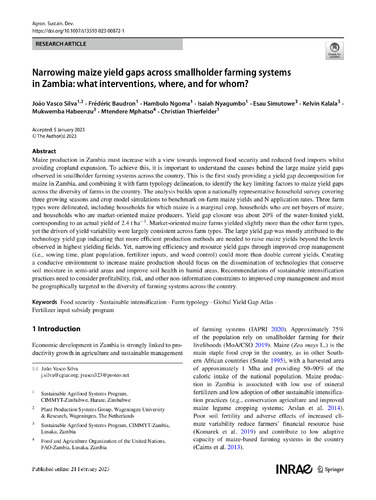Narrowing maize yield gaps across smallholder farming systems in Zambia: what interventions, where, and for whom?
Abstract
Maize production in Zambia must increase with a view towards improved food security and reduced food imports whilst avoiding cropland expansion. To achieve this, it is important to understand the causes behind the large maize yield gaps observed in smallholder farming systems across the country. This is the first study providing a yield gap decomposition for maize in Zambia, and combining it with farm typology delineation, to identify the key limiting factors to maize yield gaps across the diversity of farms in the country. The analysis builds upon a nationally representative household survey covering three growing seasons and crop model simulations to benchmark on-farm maize yields and N application rates. Three farm types were delineated, including households for which maize is a marginal crop, households who are net buyers of maize, and households who are market-oriented maize producers. Yield gap closure was about 20% of the water-limited yield, corresponding to an actual yield of 2.4 t ha− 1. Market-oriented maize farms yielded slightly more than the other farm types, yet the drivers of yield variability were largely consistent across farm types. The large yield gap was mostly attributed to the technology yield gap indicating that more efficient production methods are needed to raise maize yields beyond the levels observed in highest yielding fields. Yet, narrowing efficiency and resource yield gaps through improved crop management (i.e., sowing time, plant population, fertilizer inputs, and weed control) could more than double current yields. Creating a conducive environment to increase maize production should focus on the dissemination of technologies that conserve soil moisture in semi-arid areas and improve soil health in humid areas. Recommendations of sustainable intensification practices need to consider profitability, risk, and other non-information constraints to improved crop management and must be geographically targeted to the diversity of farming systems across the country.

